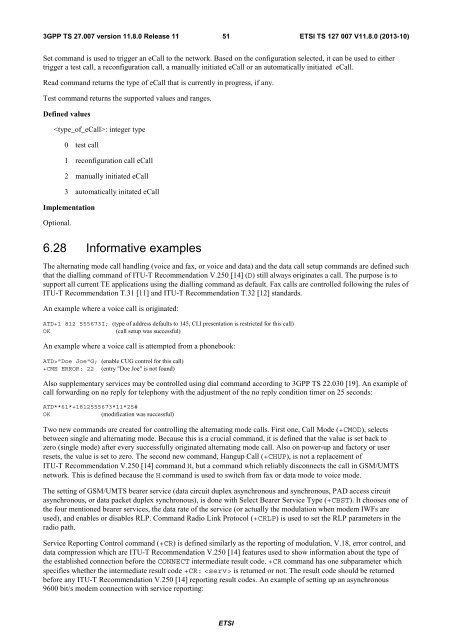ts_127007v110800p
ts_127007v110800p
ts_127007v110800p
Create successful ePaper yourself
Turn your PDF publications into a flip-book with our unique Google optimized e-Paper software.
3GPP TS 27.007 version 11.8.0 Release 11<br />
51<br />
ETSI TS 127 007 V11.8.0 (2013-10)<br />
Set command is used to trigger an eCall to the network. Based on the configuration selected, it can be used to either<br />
trigger a test call, a reconfiguration call, a manually initiated eCall or an automatically initiated eCall.<br />
Read command returns the type of eCall that is currently in progress, if any.<br />
Test command returns the supported values and ranges.<br />
Defined values<br />
: integer type<br />
0 test call<br />
1 reconfiguration call eCall<br />
2 manually initiated eCall<br />
3 automatically initated eCall<br />
Implementation<br />
Optional.<br />
6.28 Informative examples<br />
The alternating mode call handling (voice and fax, or voice and data) and the data call setup commands are defined such<br />
that the dialling command of ITU-T Recommendation V.250 [14] (D) still always originates a call. The purpose is to<br />
support all current TE applications using the dialling command as default. Fax calls are controlled following the rules of<br />
ITU-T Recommendation T.31 [11] and ITU-T Recommendation T.32 [12] standards.<br />
An example where a voice call is originated:<br />
ATD+1 812 555673I; (type of address defaul<strong>ts</strong> to 145, CLI presentation is restricted for this call)<br />
OK<br />
(call setup was successful)<br />
An example where a voice call is attempted from a phonebook:<br />
ATD>"Doe Joe"G; (enable CUG control for this call)<br />
+CME ERROR: 22 (entry "Doe Joe" is not found)<br />
Also supplementary services may be controlled using dial command according to 3GPP TS 22.030 [19]. An example of<br />
call forwarding on no reply for telephony with the adjustment of the no reply condition timer on 25 seconds:<br />
ATD**61*+1812555673*11*25#<br />
OK<br />
(modification was successful)<br />
Two new commands are created for controlling the alternating mode calls. First one, Call Mode (+CMOD), selec<strong>ts</strong><br />
between single and alternating mode. Because this is a crucial command, it is defined that the value is set back to<br />
zero (single mode) after every successfully originated alternating mode call. Also on power-up and factory or user<br />
rese<strong>ts</strong>, the value is set to zero. The second new command, Hangup Call (+CHUP), is not a replacement of<br />
ITU-T Recommendation V.250 [14] command H, but a command which reliably disconnec<strong>ts</strong> the call in GSM/UMTS<br />
network. This is defined because the H command is used to switch from fax or data mode to voice mode.<br />
The setting of GSM/UMTS bearer service (data circuit duplex asynchronous and synchronous, PAD access circuit<br />
asynchronous, or data packet duplex synchronous), is done with Select Bearer Service Type (+CBST). It chooses one of<br />
the four mentioned bearer services, the data rate of the service (or actually the modulation when modem IWFs are<br />
used), and enables or disables RLP. Command Radio Link Protocol (+CRLP) is used to set the RLP parameters in the<br />
radio path.<br />
Service Reporting Control command (+CR) is defined similarly as the reporting of modulation, V.18, error control, and<br />
data compression which are ITU-T Recommendation V.250 [14] features used to show information about the type of<br />
the established connection before the CONNECT intermediate result code. +CR command has one subparameter which<br />
specifies whether the intermediate result code +CR: is returned or not. The result code should be returned<br />
before any ITU-T Recommendation V.250 [14] reporting result codes. An example of setting up an asynchronous<br />
9600 bit/s modem connection with service reporting:<br />
ETSI


